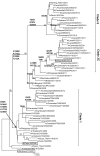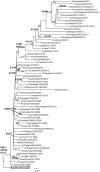Epidemiological and virological characteristics of influenza viruses circulating in Cambodia from 2009 to 2011
- PMID: 25340711
- PMCID: PMC4207757
- DOI: 10.1371/journal.pone.0110713
Epidemiological and virological characteristics of influenza viruses circulating in Cambodia from 2009 to 2011
Abstract
Background: The Cambodian National Influenza Center (NIC) monitored and characterized circulating influenza strains from 2009 to 2011.
Methodology/principal findings: Sentinel and study sites collected nasopharyngeal specimens for diagnostic detection, virus isolation, antigenic characterization, sequencing and antiviral susceptibility analysis from patients who fulfilled case definitions for influenza-like illness, acute lower respiratory infections and event-based surveillance. Each year in Cambodia, influenza viruses were detected mainly from June to November, during the rainy season. Antigenic analysis show that A/H1N1pdm09 isolates belonged to the A/California/7/2009-like group. Circulating A/H3N2 strains were A/Brisbane/10/2007-like in 2009 before drifting to A/Perth/16/2009-like in 2010 and 2011. The Cambodian influenza B isolates from 2009 to 2011 all belonged to the B/Victoria lineage represented by the vaccine strains B/Brisbane/60/2008 and B/Malaysia/2506/2004. Sequences of the M2 gene obtained from representative 2009-2011 A/H3N2 and A/H1N1pdm09 strains all contained the S31N mutation associated with adamantanes resistance except for one A/H1N1pdm09 strain isolated in 2011 that lacked this mutation. No reduction in the susceptibility to neuraminidase inhibitors was observed among the influenza viruses circulating from 2009 to 2011. Phylogenetic analysis revealed that A/H3N2 strains clustered each year to a distinct group while most A/H1N1pdm09 isolates belonged to the S203T clade.
Conclusions/significance: In Cambodia, from 2009 to 2011, influenza activity occurred throughout the year with peak seasonality during the rainy season from June to November. Seasonal influenza epidemics were due to multiple genetically distinct viruses, even though all of the isolates were antigenically similar to the reference vaccine strains. The drug susceptibility profile of Cambodian influenza strains revealed that neuraminidase inhibitors would be the drug of choice for influenza treatment and chemoprophylaxis in Cambodia, as adamantanes are no longer expected to be effective.
Conflict of interest statement
Figures





References
-
- Thompson WW, Shay DK, Weintraub E, Brammer L, Cox N, et al. (2003) Mortality associated with influenza and respiratory syncytial virus in the United States. JAMA 289: 179–186. - PubMed
-
- Dawood FS, Luliano AD, Reed C, Meltzer MI, Shay DK, et al. (2012) Estimated global mortality associated with the first 12 months of 2009 pandemic influenza A H1N1 virus circulation: a modeling study. Lancet Infect Dis 12: 687–695. - PubMed
-
- Shek LP, Lee BW (2003) Epidemiology and seasonality of respiratory tract infections in the tropics. Paediatr Respir Rev 4: 104–111. - PubMed
Publication types
MeSH terms
Substances
LinkOut - more resources
Full Text Sources
Other Literature Sources
Medical

